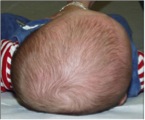Babies, like their adult counterparts, come in all shapes and sizes, but when it comes to the shape of your baby’s head, there are many factors that can play a role in its development. Many parents are concerned when their infant seems to have a less than perfectly shaped head. They often have questions about why this is and what, if anything, can be done about it. First, a little anatomy lesson of the infant skull might be helpful.
Anatomy of an infant skull
The bones of the newborn skull are malleable and moveable, thanks to fibrous sutures and fontanelles that remain unosified throughout the first years of life to facilitate vaginal delivery and allow for the expansion of the growing brain. In fact, head growth is largely determined by brain growth, and considering the brain reaches 90% of adult size by age 1 year, the skull’s capacity for expansion is essential. However, it is precisely because of this capacity, or lack thereof, that a variety of different head shapes may result. In the past, a more elongated head shape was the norm, but recently a shorter and broader head shape has become more common. This fact is largely due to the American Academy of Pediatrics’ Back to Sleep Campaign, encouraging a movement toward infant supine sleep positioning. While this has greatly helped in the reduction of SIDS cases, it has also contributed to a greater incidence of positional plagiocephaly.
The most common causes of head shape abnormalities in infants include:
Molding: This occurs when External pressure, either applied to the skull during the birthing process or resulting from uterine constraints in cases of multiple births, and usually resolves within hours or weeks of birth.

Positional plagiocephaly: This condition is one of the most common causes of infant head shape abnormalities and results when constant gravitational forces are applied to the back/side of the head when an infant remains for extended periods in the same supine position. This may also result from extended periods spent in either car seats or bouncy seats that don’t allow for positional variation. Torticollis, also called wryneck, is commonly seen in conjunction with cases of positional plagiocephaly. Infants with torticollis have restricted range of motion of the neck, often with the head tilted toward a shortened sternocleidomastoid muscle in the neck, although it is not known whether the plagiocephaly precedes the torticollis or vice versa.
Brachycephaly: This condition occurs when baby’s head is left for prolonged periods of time in a supine (or flat) position. Typically, the back of the head appears flattened with a wide shape to the head.
Scaphocephaly: This condtion is most commonly seen in premature infants and appears as an elongated facies with narrow head. Because premature infants are very susceptible
An excellent resource to determine whether your baby’s head shape is abnormal can be found here: http://www.starbandkids.com/a-simple-test
Craniosynostosis: This occurs when the sutures of the infant skull fuse prematurely, impeding skull growth in a plane that is perpendicular to the fused suture, but the skull continues to grow in the parallel plane. When this happens, the brain continues to grow in the direction of the open sutures, and different head shapes may result depending on which suture or combination of sutures has fused. Craniosynostosis can also be associated feature of several genetic syndromes.
For parents wondering about imperfections in their infant’s head shape, speaking to a pediatrician can help pinpoint issues and determine if there is cause for concern. There are many factors that contribute to differences in the shape of an infant’s head, but because treatment is most effective at the onset of symptoms, early and accurate diagnosis is essential. A pediatrician can help diagnose exactly what is causing the abnormality and which treatment options are best.
In most cases of positional plagiocephaly, there are a few simple steps parents can take to encourage a variety of positioning and optimum range of motion for the neck in order to avoid issues like torticollis. First, infants should lie, play, feed and be carried in a variety of positions. Rotating the infant’s orientation in the crib at least daily, encouraging them to focus their attention in different directions can be extremely beneficial, and tummy time every day is key. However, when these techniques are not effective, physical therapy or helmet therapy may be considered.
In cases of craniosynostosis, examination by a pediatrician is critical, and referral to other specialists, including pediatric craniofacial or neurosurgical experts, may be in order.





Find us in: